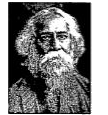Rabindranath Tagore gave up his knighthood because of:
Jallianwala Bagh Massacre
Brutal suppression of civil disobedience
Execution of Bhagat Singh
Chauri-Chaura incident
The correct Answer is:A
Similar Questions
Which one among the following prompted Rabindranath Tagore surrender his title of 'Sir'. ?
View SolutionIn his lectures on nationalism, Rabindranath Tagore argued that
1. nationalism frees men a women from narrow loyalties and bonds, and connects them to wider and better community of fellowship
2. nationalism will foster a feeling of rootedness and cultural belonging, and put an end to warmongering
Select the correct answer using the code given below.
View Solution
Knowledge Check
As a means of protest against which of the following incident, Rabindranath Tagore gave up his honor of knighthood?
APartition of BengalBPress Act of 1910CJallianwala Bagh massacreDSalt LawRabindra Nath Tagore gave up his 'Knighthood' in protest to which one of the following?
ARowlatt ActBMassacre at Jallianwala BaghCSimon CommissionDCripps MissionAssertion (A): Rabindra Nath Tagore relinguished the Knighthood.
Reason (R) : The Jallianwala Bagh massacre caused deep anguish in the heart of Rabindra Nath Tagore and that prompted him to relinguish the Knighthood.ABoth A and R are true and R is the correct explanation of ABBoth A and R is true but R is not a correct explanation of ACA is true but R is falseDA is false but R is true
Study the picture and answer the question which follow:

Rabindranath renounced his Knighthood after -
View SolutionConsider the following statements A and B and choose the correct answer
A. In April 1919 ,the Jallianwala Bagh Atrocities inflicted by General Dyre in Amritsar on Baisakhi day .
B. Rabindranath Tagore expressed his pain and angle of the country by renounching his knighthood .
View SolutionArab poet Shihab Ghanem bagged the Rabindranath Tagore Peace Prize for his translation of Indian works into both the Arabic and English language.
Consider the following statements about this award.
1. This is given biannually.
2. This is instituted on the 150th birth anniversary of Tagore, for promoting values of universal brotherhood.
Select the correct answer using the codes given below.
View SolutionGitanjali' by Rabindranath Tagore is a collection of _____.
View SolutionRead the given passage and answer the questions that follow.
Santiniketan embodies Rabindranath Tagore’s vision of a place of learning that is unfettered by religious and regional barriers. Established in 1863 with the aim of helping education go beyond the confines of the classroom, Santiniketan grew into the Visva Bharati University in 1921, attracting some of the most creative minds in the country. He developed a curriculum that was a unique blend of art, human values and cultural interchange. Even today, in every step, in every brick and in every tree at Santiniketan, one can still feel his presence, his passion, his dedication and his pride in the institution. In 1862, Maharishi Debendranath Tagore, father of Rabindranath, was taking a boat ride through Birbhum, the westernmost corner of Bengal, when he came across a landscape that struck him as the perfect place for meditation. He bought the large tract of land and built a small house and planted some saplings around it. Debendranath Tagore decided to call the place Santiniketan, or the ‘abode of peace’, because of the serenity it brought to his soul. In 1863, he turned it into a spiritual centre where people from all religions, castes and creeds came and participated in meditation.
In the years that followed, Debendranath’s son Rabindranath went on to become one of the most formidable literary forces India has ever produced. He wrote in all literary genres but he was first and foremost a poet. As one of the earliest educators to think in terms of the global village, he envisioned an education that was deeply rooted in one’s immediate surroundings but connected to the cultures of the wider world.
Located in the heart of nature, the school aimed to combine education with a sense of obligation towards the larger civic community. Blending the best of western and traditional eastern systems of education, the curriculum revolved organically around nature with classes being held in the open air. Tagore wanted his students to feel free despite being in the formal learning environment of a school, because he himself had dropped out of school when he found himself unable to think and felt claustrophobic within the four walls of a classroom. Nature walks and excursions were a part of the curriculum, special attention was paid to natural phenomena and students were encouraged to follow the life cycles of insects, birds and plants.
The rural paradise of Santiniketan, Tagore’s erstwhile home, has become a thriving centre of art, education and internationalism over the years.
Tagore’s ‘erstwhile’ home means:
View Solution
